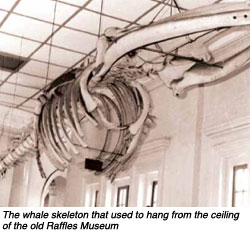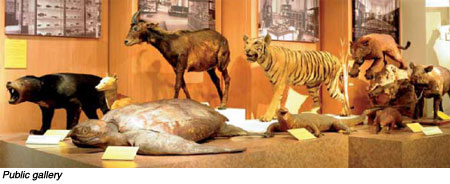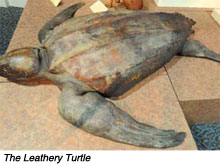|
by Toh Chay Hoon and Tan Swee Hee
Did you know that a Leathery Turtle was found at Siglap in 1883?
  id you know that amazing biodiversity once inhabited Singapore? Did you know that despite her small size and the loss of habitat, Singapore boasts an amazing amount of biodiversity? Do you know where to find it? A visit to the Raffles Museum of Biodiversity Research (RMBR) is bound to make you rethink your ideas about Singapore and Nature. id you know that amazing biodiversity once inhabited Singapore? Did you know that despite her small size and the loss of habitat, Singapore boasts an amazing amount of biodiversity? Do you know where to find it? A visit to the Raffles Museum of Biodiversity Research (RMBR) is bound to make you rethink your ideas about Singapore and Nature.
Situated on the third storey of Block S6 at the National University of Singapore's (NUS) Kent Ridge Campus, the RMBR is Singapore's only natural history museum. The RMBR owns one of Southeast Asia's earliest natural history collections, and leads this region in biodiversity research. Through various displays and exhibits, visitors will discover for themselves the astounding array of fauna and flora of Singapore and the region. They often leave RMBR with a better understanding of this richness, and hopefully, with newfound concern for the loss of Singapore's native natural heritage.
The Origins
The origins of the RMBR go back to 1849 with the establishment of the Raffles Museum, whose namesake - Sir Thomas Stamford Raffles - is a notable naturalist. It was Raffles - idea to build a depository for specimens of the region's natural history. The Raffles Museum at Stamford Road housed many of such specimens collected by the British. From its establishment, it grew to become a world-renowned zoological institution. The centrepiece of this institution, at which children and adults alike would gaze at in awe, was a set of whale skeleton that hung from the ceiling of the museum.
With a change of name in 1965 to the National Museum of Singapore, the emphasis of the institution shifted to the arts and national development. Deemed to be of little value, it was suggested that the zoological collection be given or thrown away. That icon, the whale skeleton, was unfortunately lost at this time. Thankfully, a happier fate befell the rest of the collection - it was rescued and guarded by dedicated zoologists from the then University of Singapore for a good 15 years, but with neither a home nor support. In 1987, the collection was finally given a small permanent home at NUS and in 1998, the zoological collection and herbarium were renamed the RMBR.
Public Gallery
 In 2000, a small Public Gallery began showcasing a small fraction (0.1%) of the museum's collection. The exhibits a visitor first encounters introduces them to the biodiversity of Singapore. These include a huge jellyfish and a large King Cobra. Most specimens are accompanied by information for the curious visitor. In 2000, a small Public Gallery began showcasing a small fraction (0.1%) of the museum's collection. The exhibits a visitor first encounters introduces them to the biodiversity of Singapore. These include a huge jellyfish and a large King Cobra. Most specimens are accompanied by information for the curious visitor.
The next exhibit showcases the big animal specimens of Southeast Asia, including the only Leathery Turtle that was found in Singapore at Siglap in 1883. A small display also shows some of the bizarre things that people get from nature and turn into food! The Gallery ends with a section about Sir Stamford Raffles, the naturalist who started it all. This free visit will be a rewarding educational experience to any casual visitor.
Public Education
The RMBR also offers educational workshops and programmes for teachers and students on natural history and ecology. These emphasize learning through stimulating cutting-edge content delivered through engaging hands-on experiences.
The activities aim to arouse curiosity and educate students about the rich natural heritage in Singapore; to show the need for conservation in Singapore; to foster experiential-learning and creative thinking in students; and to provide students with opportunities to carry out research projects and interact with scientists.
Building A New Home!
 The increasing awareness of our planet's fragility and the need for us to better care for it has meant that public support for the museum, its history, collections and research has grown tremendously. Furthermore, Nature's role in our daily socio-economic activities and well-being has come to capture the public's attention. The increasing awareness of our planet's fragility and the need for us to better care for it has meant that public support for the museum, its history, collections and research has grown tremendously. Furthermore, Nature's role in our daily socio-economic activities and well-being has come to capture the public's attention.
With this increased need, the RMBR is raising funds to furnish a much larger exhibition hall to provide larger and more comprehensive exhibits. A new museum will be built at a new location that will be more accessible to the public. It will ensure that the collections are protected for posterity. Join us in our endeavour and help the world see Singapore's native natural heritage.
 Click here to download the full issue for USD 6.50 Click here to download the full issue for USD 6.50
|



 id you know that amazing biodiversity once inhabited Singapore? Did you know that despite her small size and the loss of habitat, Singapore boasts an amazing amount of biodiversity? Do you know where to find it? A visit to the Raffles Museum of Biodiversity Research (RMBR) is bound to make you rethink your ideas about Singapore and Nature.
id you know that amazing biodiversity once inhabited Singapore? Did you know that despite her small size and the loss of habitat, Singapore boasts an amazing amount of biodiversity? Do you know where to find it? A visit to the Raffles Museum of Biodiversity Research (RMBR) is bound to make you rethink your ideas about Singapore and Nature.
 In 2000, a small Public Gallery began showcasing a small fraction (0.1%) of the museum's collection. The exhibits a visitor first encounters introduces them to the biodiversity of Singapore. These include a huge jellyfish and a large King Cobra. Most specimens are accompanied by information for the curious visitor.
In 2000, a small Public Gallery began showcasing a small fraction (0.1%) of the museum's collection. The exhibits a visitor first encounters introduces them to the biodiversity of Singapore. These include a huge jellyfish and a large King Cobra. Most specimens are accompanied by information for the curious visitor.
 The increasing awareness of our planet's fragility and the need for us to better care for it has meant that public support for the museum, its history, collections and research has grown tremendously. Furthermore, Nature's role in our daily socio-economic activities and well-being has come to capture the public's attention.
The increasing awareness of our planet's fragility and the need for us to better care for it has meant that public support for the museum, its history, collections and research has grown tremendously. Furthermore, Nature's role in our daily socio-economic activities and well-being has come to capture the public's attention.
 Click here to download the full issue for USD 6.50
Click here to download the full issue for USD 6.50